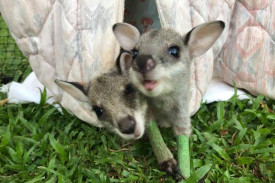Community
17 June, 2021
Become a wildlife foster parent
SPRING is a magical time in the far north, when birds and bees take to the air and baby animals peek out of their mothers’ pouches and nests.

Unfortunately, it’s also the busiest season for wildlife carers, because wildlife killed by cats, dogs, traffic and other threats at this time of year are likely to leave orphaned babies behind.
To make sure all these precious orphans are cared for, Wildlife Carers FNQ (WCFNQ) needs dozens of new volunteer rescuers, carers and transporters in the far north to sign up this month to receive training ahead of the spring season.
Not only baby animals, but also sick and injured adults are rescued, rehabilitated and then taken to dedicated release sites by the charity.
Full training is provided and each volunteer will have a mentor to help them with caring for their first animals.
Animals helped include kangaroos, wallabies, flying foxes, microbats, birds, lizards, non-venemous snakes, frogs, freshwater turtles, gliders, bandicoots and more, although each volunteer can care for a certain type of wildlife depending on their resources and experience.
“Caring for a baby animal such as an agile wallaby can take up to six months from rescue to pre-release, and it’s a big commitment especially in the early stages when the animal needs regular feeding, but it is one of the most rewarding things you will ever do,” said WCFNQ president Kim Sandford.
“If you have been thinking of getting a pet like a cat or dog, have you considered investing your time and money into caring for a native animal instead? It’s a great way to give back to our beautiful far northern environment when wildlife are finally released.”
For those unable to commit to caring, the charity is also looking for members to help with checking specific black spots, transporting animals, rescuing, building bird and possum boxes, sewing pouches, creating items for sale or being part of the committee and sub committees, as well as for fundraising, with helpers needed for a Bunnings sausage sizzle on June 26.
Ms Sandford said the group also needed donations and sponsors to help with feed, housing and medication.
“All our volunteer carers pay for the care of the wildlife they look after out of their own pockets and for some it’s not cheap - our recent flying fox season has seen one of our carers look after 184 flying foxes, most of which have now been released but are still being support fed, and to date it has cost her $20,000,” she said.
“It costs $100 to buy a four-kilogram bag of wombaroo kangaroo milk which will feed two agile wallaby joeys for 16 weeks, and currently we have 20 in care with our carers.”
Ms Sandford said the charity’s work was vital in protecting threatened endemic species.
“The spectacled flying fox, native to Far North Queensland, is near extinction with an estimated 52,000 left in the wild,” she said.
“Just like bees, flying foxes play a crucial role in keeping our incredible, local ecosystem healthy - a single flying fox can travel up to 50 kilometres per night, pollinating flowers and dispersing seeds as they forage for food in the rainforests.
“Without them our entire ecosystem will eventually collapse.”
Membership is $40 which covers the cost of insurance, training and mentoring.
For more information visit www.wcfnq.org.au





